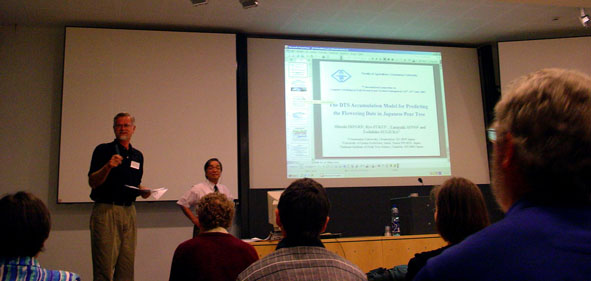
International Symposium on Computer Modelling in Fruit Research
(2004.6.20-24) , Copenhagen, Denmark
Hitoshi HONJO1), Ryo FUKUI1), Yasuyuki AONO 2) and Toshihiko SUGIURA 3)
1) Utsunomiya University, Utsunomiya, Tochigi 321-8505, Japan
2) Osaka Prefecture University, Sakai, Osaka 599-8531, Japan
3) National Institute of Fruit Tree Science, Tsukuba, Ibaraki 305-8605, Japan
‘Kousui’, ‘Housui’ and ‘Nijisseiki’ Japanese pears (Pyrus pyrifolia Nakai) are major cultivars in Japan. The flowering time is a matter of great importance to the fruit growers and the experts concerned. To estimate the flowering time, the accumulation model of index refered as DTS (the number of days transformed to standard temperature) is used in this study.
The flowering date of Japanese pear trees (cvs. Kousui, Housui and Nijisseiki) was monitored at 21 experiment stations in various pear-grown regions throughout Japan. DTS accumulation model based on air temperature data is developed applicable for almost stations. The Model was verified using the root mean square error (RMSE) for difference in days between the actual and estimated flowering dates. The RMSE in warm (or southwest) regions became larger than other regions in Japan. Analysis by DTS method indicated that the estimated flowering dates were slightly ahead of the actual flowering dates at most stations. It was assumed that urban warming around the meteorological observatories could cause the same error in estimation. To test this hypothesis, the influences of the urban warming on flowering dates at Utsunomiya city were evaluated by the DTS accumulation model.
Keyword: DTS accumulation model, endodormancy, flowering, global warming, Japanese pear (Pyrus pyrifolia Nakai), urban warming

発表風景:Royal Veternary and Agricultural University, Frederiksberg campus

大学近くの町並み


世界遺産:Roskilde Cathedral


クロンボー城(Klonborg Slot):フレデリクス2世が1585年に建築したデンマーク・ルネッサンス様式 / The Little Mermaid